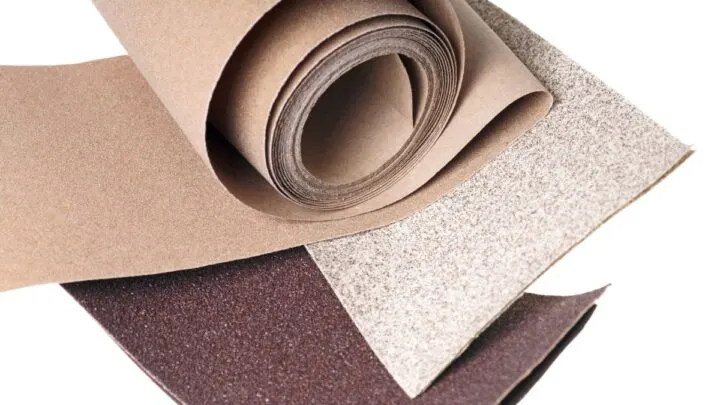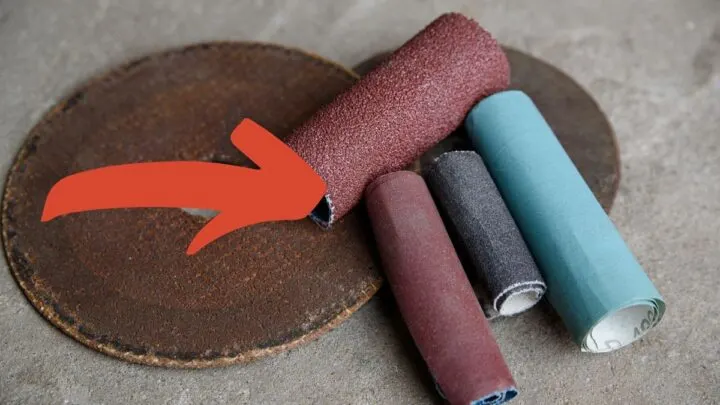With so many sandpapers available, it is easy to make mistakes when selecting or using them. So, what kind of sandpaper do you use on metal?
Sandpaper can be used for cleaning, preparing the surface for paint or other coatings, and polishing.
You should use silicon carbide or aluminum oxide sandpaper with any grit higher than 320 for metal. If you are preparing a surface and need to remove rust, you should use a coarser grit.
If you need to polish metal, you should use fine grit to ensure a smooth finish.
Most metals scratch easily. This is a common issue that most novice sanders face. If you use the wrong grit, you can easily end up with a poorly finished piece.
Using the correct sandpaper to protect the metal surface from unwarranted damages is essential.
Many novice DIY project enthusiasts will often pick up any sandpaper they find lying around and start scrubbing the surface they need to sand.
However, this often results in scratching and damaging the surface. When finishing and polishing, you must use finer grit and coarser grit when cleaning and preparing surfaces.
What is Sandpaper Grit?
Sandpaper is composed of tiny abrasive particles called grit or grains. These abrasive particles can be made from natural sources or artificially manufactured compounds.
The grain of the compound is sorted and bound together using a cloth, paper, or sponge backing.
The result is a coarse material for sanding on one side and a smooth surface to place your hand on the other.
You must distinguish the grit size on different sandpapers, as each grit serves a different purpose.
The grit size is often determined by numbers, which signify the grain size and range from 20 to over 1000.
As the value of the grit increases, the grains responsible for abrasion become smaller, resulting in finer sandpaper.
For instance, a 400 grit sandpaper will be finer than a 100 grit sandpaper.
With every pass over the surface, the coarser sandpaper will take off more of the surface than the higher grit one.
Sandpaper Compound For Metal
In addition to the grit, you will need to pay attention to the material compound that the sandpaper is made of. There is a broad range of sandpaper compounds available.
However, two common types are used for working with metals: aluminum oxide and silicon carbide.
Aluminum oxide sandpaper is usually tougher and used on belt sanders and grinding discs.
Brown aluminum oxide sandpapers have unique crystals in the grit, which break down and create a new layer for better sanding.
Silicon carbide sandpaper is more suited for preparing surfaces or adding finishing touches.
The silicon carbide grit remains consistent and ensures a better finish than aluminum oxide.
Since the compound is softer, it is better suited for hand sanding than with power tools, where it will wear out rapidly.

What Kind of Sandpaper Do You Use On Metal?
If you plan to paint or coat a metal surface, you will need to ensure that the surface is clean and free of dust, rust, and any other coatings.
There is a broad range of grits to choose from depending on whether you want to perform aggressive abrasion or light smoothening and polishing.
If you need to remove rust or prepare a surface for applying primer, you will require a lower grit, such as 100 or 200.
This paper will often leave deep scratches, which are not good on a finished product but are suitable for helping the primer stick to the surface.
If you use a finer grit, such as 1000, you will end up with a smoother surface. However, it will take more than just a few passes to get the desired finish.
You may hardly ever need to use 1000 grit or higher sandpaper on a metal surface unless you plan to coat the surface with a clear coat.
When working with metal, you will require multiple grit sandpapers to get the best results.
How To Sand Metal
There are several power tools that you can use to sand down metal. Which tools you use will depend on the job you plan to complete.
1. By Hand
The simplest way to sand metal is to use a sanding block. These blocks allow you to apply even pressure on the surface you are sanding.
They are suitable for sanding hard-to-reach areas but can take too long to work on thick rust.
Sanding blocks are not too expensive and allow you to work with different grits of sandpapers.
2. Orbital Sanders
Orbital sanders allow the sandpaper to move randomly along the metal surface, minimizing the chances of deep scratches.
Most orbital sanders are equipped with lower grits, such as 320 or less, which works great for removing old coatings and rust.
They will make the job easier and give results faster than hand sanding. However, they will also be dustier and may require you to clean the workpiece from time to time.
3.. Belt Sanders
Belt sanders are more suited for woodwork than metalwork. But the people who use them on metal find them to be excellent tools for removing paint and rust.
The belt size can be varied to allow you to work in different areas. Narrow belts are suitable for working on box-shaped workpieces and can help with working corners and edges.
Wide belts are suited for flat surfaces such as metal sheets and plates.
4. Grinders
Grinders are probably the fastest way to get the rust off a metal surface. Most grinders come with coarse discs with a grit of 100 or less.
However, there are a few drawbacks to using grinders. To begin with, they will not leave a refined and polished surface. They are only suited for surfaces that will be painted or coated later.
Furthermore, using grinders is tricky. It is common for a grinding disc to stick in a corner, causing the grinder to slip out of hand.
This can result in serious injuries. Grinders should be used by experienced people rather than novice metalworkers.
Summing Up Sandpaper to Use on Metal
If you’re looking to sand down metal, you should be using silicon carbide or aluminum oxide sandpaper with a grit higher than 320. This will allow for maximum sanding without scratching the surface of the metal.
There are a few different tools to utilize so you can sand down the metal, including grinders and orbital sanders.
Whichever tool you decide to use, be safe!


